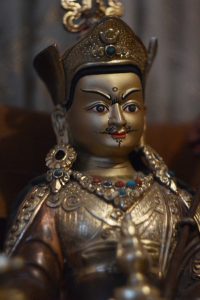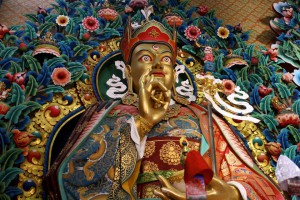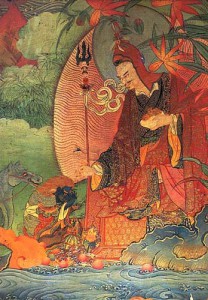Friday
Dharma TeachingsSupplication to Padmasambhava 1
Some background to help us understand a supplication chant to Guru Rinpoche
by Russell Rodgers
Buddhism’s tremendous success in Tibet can be traced to the activities of an eighth century Indian yogi named Padmasambhava, known by Tibetans as “Guru Rinpoche.” His story is important for us here in the modern West because it illustrates how Buddhism can enter and tame a foreign culture. In his case, the new culture was Tibet. In our case, it is us. The founder of Shambhala Buddhism, the Vidyadhara Chögyam Trungpa Rinpoche, drew extensively on the experience of Padmasambhava for his work in North America.
In the eighth century, India was a highly developed civilization, with great universities and a highly developed spiritual tradition. The king of Tibet, Trisong Detsen (755-797), wishing to bring literacy and spiritual sophistication to Tibet, invited a great Indian Mahayanist scholar, Shantarakshita, to present the foundation teachings of Buddhism. However, many obstacles arose when he came to Tibet. Some were political, some were cultural, some were psychic, and some were environmental. Realizing that something else was needed, Shantarakshita told the king to invite Padmasambhava, an Indian tantric yogin of great power.
Padmasambhava’s realization was so profound that he was able to contact the basic energies that underlay the apparent obstacles, and re-cast them as aids to practice. Instead of attempting to destroy the mountain gods and demons of the native Tibetan religion, he harnessed these energies into the form of protectors of the dharma. In this way he tamed the Tibetan national psyche. One might ask how this situation parallels our own.
When the Chögyam Trungpa Rinpoche came to North America in the early 1970’s, he found on the one hand a tremendous interest in dharma, and on the other, as in Padmasambhava’s Tibet, a cultural environment that needed to be tamed. For dharma to truly take root, it couldn’t just be an exotic transplant of foreign culture. Buddhism would have to embrace, and then transform the barbarism of the West— corporate culture, militarism, materialistic consumerism, and theism.
The example of Padmasambhava was very real to Trungpa Rinpoche. Padmasambhava didn’t try to block the energies that he encountered in Tibet: he embraced them and extracted their wisdom. Whatever he encountered became further fuel to his activities. This approach is called “crazy wisdom,” and it does not work on conventional logic at all. It is based on complete nowness. It is completely uncompromising in seeing and responding to the sacredness of all situations. If the word “sacredness” here creates difficulty, we could probably substitute the words basic goodness, or primordial purity. This sacredness is generally covered over by conceptual projections about reality, and since that “reality” is where we live most of the time, the actions of such a yogi will seem crazy–coming from someplace that is strange and unfamiliar to us.
Following the example of Padmasambhava, the Vidydhara did not block the energies he found in the West, but transformed them. To transmute militarism, for instance, the Vidyadhara introduced the kasung, or vajra guards, whose motto was “victory over war,” and who replace violence with presence, awareness, and spontaneous action. He structured the governing body of his organization along Western corporate lines, and then taught people the principles of enlightened leadership. He worked with materialistic consumerism by teaching how to appreciate the natural richness of our perceptions and the ability of perceptions to wake us up. He worked with theism by showing how to use the power of deities in spiritual practice, without solidifying them as external ego. Like Padmasambhava, he extracted the wisdom energy of each situation from under its egoistic cloak.
When we invoke Padmasambhava in this chant, we are invoking his enlightened example as a way to work with the obstacles we encounter—whether they are personal, or obstacles in our physical or social environment. Tibetans believe that Padmasambhava still exists, and that he relates to our world from his enlightened realm. We could understand the chant in this way, or we could understand that we are invoking an enlightened aspect of mind in general. In the latter case, Padmasambhava represents part of ourselves that is there but not normally accessible to us. Obviously, our understanding of what this means comes from some kind of contact with present day holders of Padmasambhava’s lineage.
 Russell Rodgers has been wondering about this kind of topic for the 39 years that he has been practicing. He resides in the Kootenay mountains of British Columbia, in the town of Nelson, and has graciously agreed to allow publication of his beautiful essays on the Shambhala chants here in the Times.
Russell Rodgers has been wondering about this kind of topic for the 39 years that he has been practicing. He resides in the Kootenay mountains of British Columbia, in the town of Nelson, and has graciously agreed to allow publication of his beautiful essays on the Shambhala chants here in the Times.






